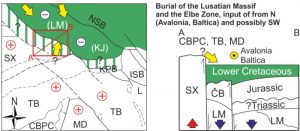 Since the pioneering works of early 20th century, Late Cretaceous sandstones along the Lusatian Fault were interpreted as sourced from the West Sudetic Island. However, the original concept that basement of the Lusatian Block directly supplied a clastic material to the Late Cretaceous shores and deltas, has been recently challenged. New LA-ICP-MS U–Pb dating of detrital zircons and heavy mineral analysis of Permian, Jurassic, and Upper Cretaceous formations revealed diachronous basin formation and subsequent inversion by reactivation of major faults in the northern Bohemian Massif. In turn, the Middle Jurassic–Early Cretaceous sedimentary cover of the Lusatian Block was redeposited by its later uplift and unroofing. This paper proves that the Bohemian Creatceous Basin is not only an excellent archive of paleoclimate changes, but its record may contribute to deciphering relatively enigmatic post-early Permian tectonosedimentary history of the surrounding basement areas.
Since the pioneering works of early 20th century, Late Cretaceous sandstones along the Lusatian Fault were interpreted as sourced from the West Sudetic Island. However, the original concept that basement of the Lusatian Block directly supplied a clastic material to the Late Cretaceous shores and deltas, has been recently challenged. New LA-ICP-MS U–Pb dating of detrital zircons and heavy mineral analysis of Permian, Jurassic, and Upper Cretaceous formations revealed diachronous basin formation and subsequent inversion by reactivation of major faults in the northern Bohemian Massif. In turn, the Middle Jurassic–Early Cretaceous sedimentary cover of the Lusatian Block was redeposited by its later uplift and unroofing. This paper proves that the Bohemian Creatceous Basin is not only an excellent archive of paleoclimate changes, but its record may contribute to deciphering relatively enigmatic post-early Permian tectonosedimentary history of the surrounding basement areas.
Nádaskay R., Žák J., Sláma J., Sidorinová T., Valečka J. (2019): Deciphering the Late Paleozoic to Mesozoic tectonosedimentary evolution of the northern Bohemian Massif from detrital zircon geochronology and heavy mineral provenance. International Journal of Earth Sciences 108, 2653-2681. (DOI)








